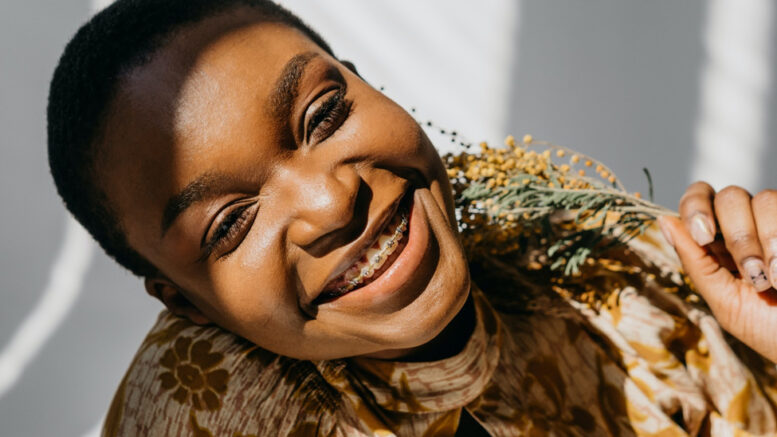While we might tend to think of them as being separate, our physical and mental health are closely interconnected. A common example of this might be muscular tension in the neck, nausea related to anxiety, or tooth grinding due to stress.
How we feel about our body image can also have a significant impact on our mental and emotional state. Body image is a combination of how we perceive our own appearance and ideas about what the “ideal” body image looks like.
How Body Image Relates to Orthodontics
In some cases, people may have an exaggerated sense that an aspect of their physicality (for example, their teeth) is unattractive. This is known as body dysmorphia, where a distorted sense of body image contributes toward negative feelings surrounding physical appearance.
In a 2017 study, dental disorders such as tooth loss or misalignment were found to have a significant effect on the self-esteem of adolescents (a group that tends to be highly vulnerable to body image-related issues), though if left untreated the physical, emotional and mental impact of poor body image can affect people at any age.
Far Reaching Effects
While the focus of body image often tends to surround issues related to the shape and size of the body overall, issues surrounding the appearance of the teeth and gums can impact mental and emotional health at a fundamental level by affecting how confident a person feels when they smile or laugh.
In a broader sense, orthodontics can have an impact on various aspects of a person’s life including social factors such as dating. This even extends to the workplace: research shows that interview candidates with straight teeth are 45% more likely to get a job despite the majority (if not all) professions having nothing to do with the dental alignment of prospective candidates.
Form vs. Function
The main purpose of orthodontics is twofold: firstly, to address any issues that cause pain or discomfort and affect overall function. The second purpose has more to do with aesthetics. At times, these may be connected: for example, re-alignment of the teeth may also improve related difficulties with speech and eating.
Similarly, approaches to dealing with body issues tend to center either on form or function: while body positivity tends to be about the perceived aesthetic beauty of the body (regardless of idealized, unattainable beauty standards), body neutrality focusses on appreciation for what the body is able to do in a functional sense.

Hollywood Smiles
Both aesthetics and function are important in their own way, yet the pressures of modern beauty standards tend to place excessive focus on personal appearance. Daily exposure to idealized, unattainable and (thanks to innovations in beauty filters and editing on social media)
unrealistic beauty standards.
Orthodontic work is a personal choice -yet striving for unattainable levels of perfection can create results that tend to look a little strange: particularly over whitened, uniformly straight teeth, a look frequently associated with the aspirational “Hollywood smile.”
It’s worth noting some perfectly-imperfect real Hollywood smiles that are instantly recognisable because of their unique dental quirks: Kirsten Dunst’s pronounced incisors, for example, or the gap-toothed grins of Madonna and Willem Dafoe.
Understanding Aesthetics
As a concept, attractiveness is largely subjective, but for many people it also tends to be heavily influenced by the images of bodies and faces we see on social media. This can lead to unfavorable comparisons which then have a negative impact on our mental and emotional state. Learning how to differentiate between the “fantasy” of idealized body images and real life is key, as is the development of emotional skills like self acceptance.
The Missing Piece
The quest for perfection is not only impossible to attain, it can also affect the expectation levels of someone seeking orthodontic treatment. Body issues can lead to a tendency to overfocus or even obsess about a particular physical feature, with the assumption that once this is “corrected”, all other aspects of a person’s life will fall into place.
Orthodontics are not a cure-all designed to solve the sum total of a person’s problems. As with any form of aesthetic procedure, going in with realistic expectations about what the procedure will achieve is essential: a straighter, more even smile will not immediately remedy all of life’s problems, but it can provide a significant confidence boost.
The Mind Body Connection
Poor body image can also affect how we treat our bodies in terms of self care. Body image issues may lead to a range of related problems such as eating disorders, creating a vicious cycle of low self-esteem and poor self-care (for example neglecting to brush teeth due to depression).
Poor oral health can even affect areas of the body other than the teeth and gums: for instance in cases of TMJ (temporomandibular joint) disorders. This primarily affects the jaw but can also lead to pain in the back, neck and other areas of the body.
Socioeconomic Factors
According to Harvard Medical School, income inequality has a long association with poor oral health outcomes as well as poor mental and emotional wellbeing. Part of this can be due to difficulty accessing affordable dental care.
While orthodontic procedures are now more readily available than they were during the early stages of orthodontics in the 16th to the 18th centuries (when procedures like tooth alignment were reserved for the wealthy), barriers to accessing orthodontic treatment persist even today for low-income households living paycheck to paycheck.
This has even prompted some to resort to attempted “at home” methods of orthodontics. Alternatively, some people seek orthodontic work from unqualified practitioners offering work for cheap. In either case, this can be risky: additional damage to teeth and gums only worsens a pre-existing problem, negatively impacting your health and leading to further expense and unnecessary stress.
Accessing Affordable Orthodontic Care
Besides choosing a qualified orthodontist, it’s also worth shopping around for the best dental insurance plan. In some cases you may even be able to receive treatment from dentists-in-training. However, this route may take a little longer and it’s advisable to choose a reputable school with good credentials.
For families on low incomes living paycheck to paycheck, there’s charitable foundations like the Smiles Change Lives program or the Smile for a Lifetime Foundation, but as a starting point, speak with your local orthodontist about negotiating a financial plan that helps you stay within budget. If you happen to be based in Utah, contact your local orthodontics West Jordan practice to find out more about affordable payment plans for you and your family.
